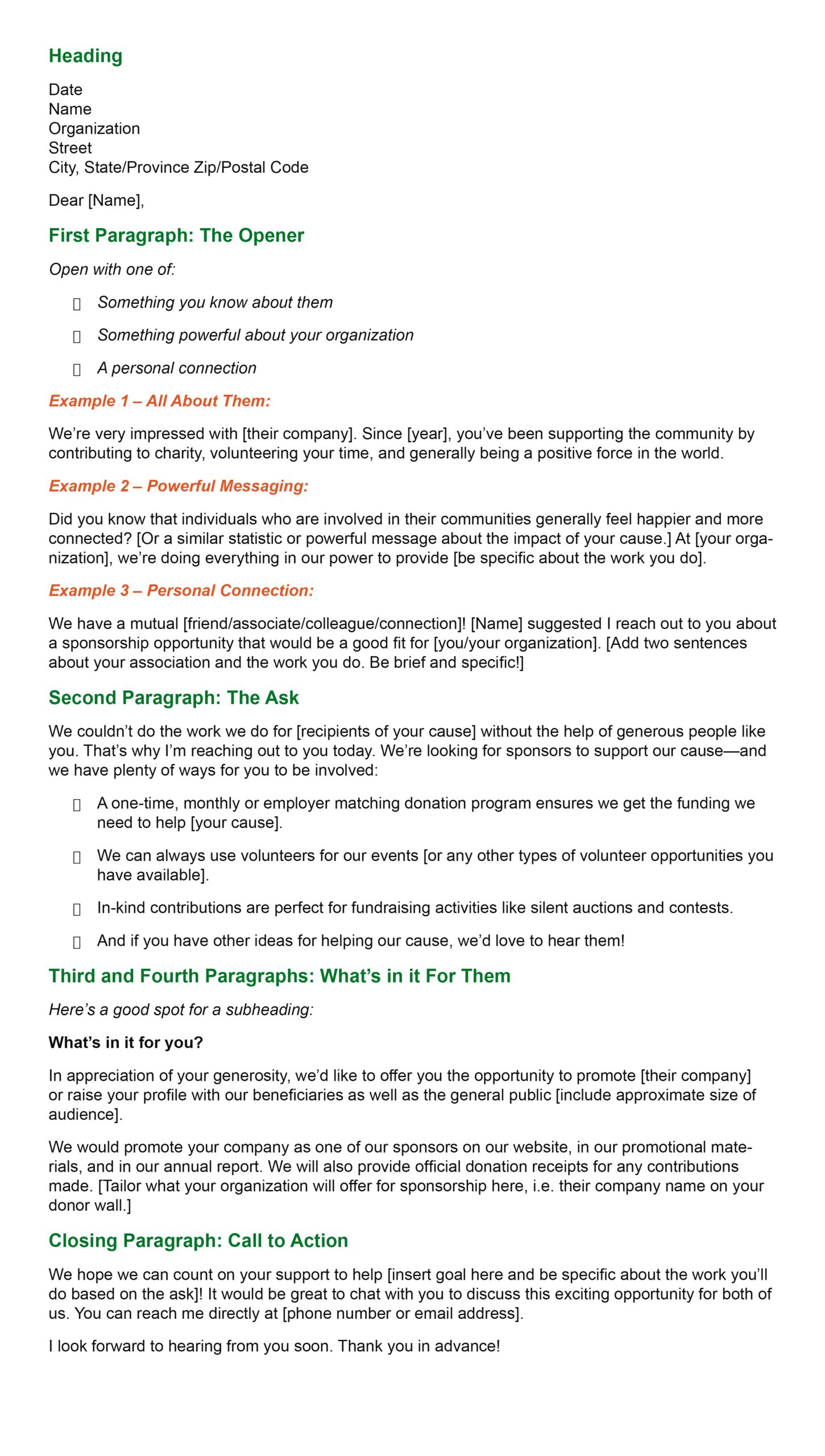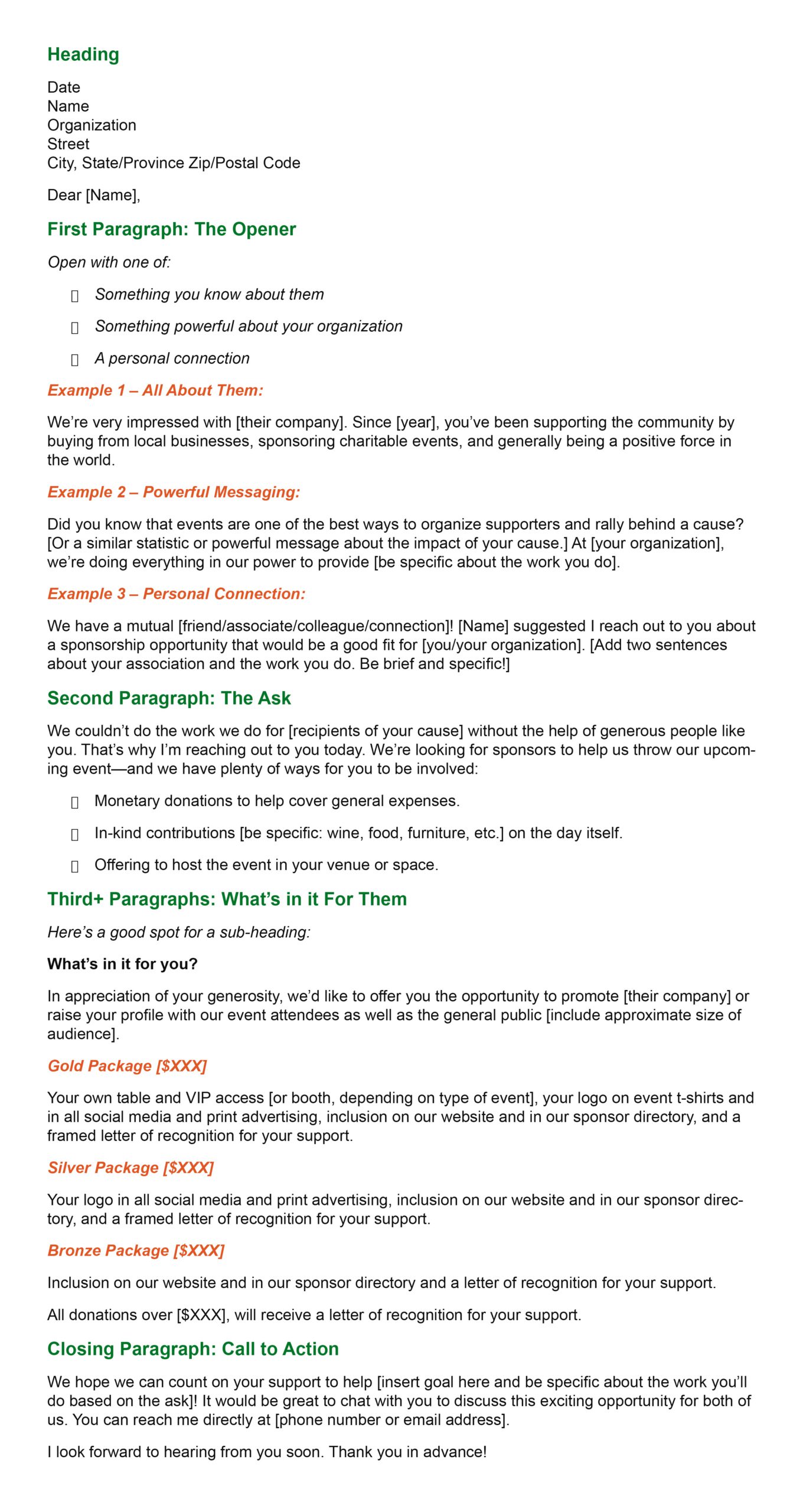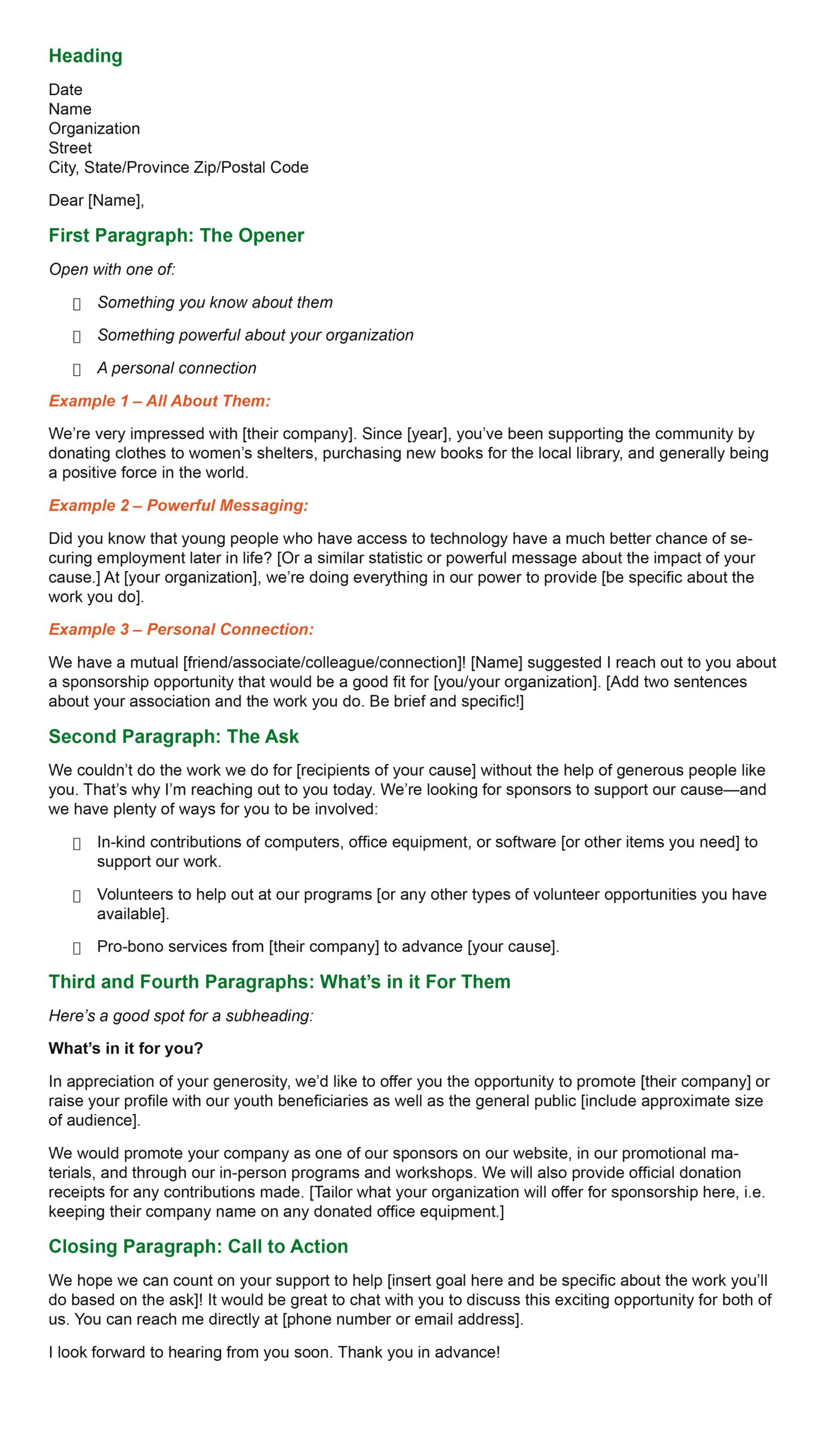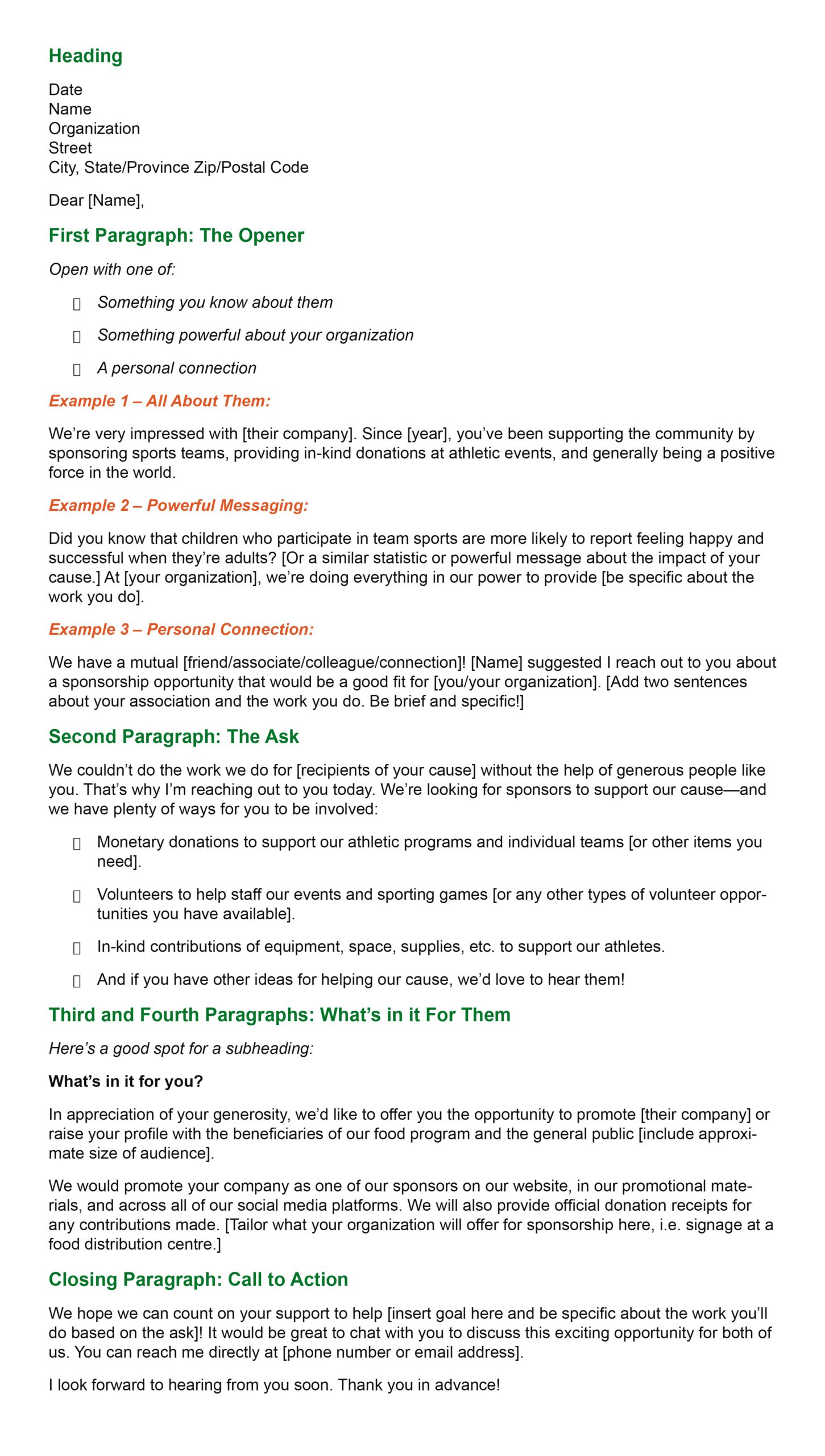

Sponsorships can take your fundraising efforts to new heights—elevating your events, opening up partnership opportunities and more. They’re all about making lasting relationships with donors. But how do you kickstart these connections and start bringing in donations that pack an impact? There’s a tried and true tactic: writing sponsorship letters. Of course, getting sponsorships isn’t as easy as sending out a few letters. But if you’ve already identified some warm leads, had some phone calls and are ready to explore further opportunities with an organization, then that’s where sponsorship letters, and this post, come in handy. We’ll cover everything you need to know about sponsorship letters: what they are, how to write them, who to send sponsor letters to. Plus, we’ve got samples and templates to get you started! Read more: Seven Sponsorship Letter Templates For Every Situation

Unlike a standard fundraising letter that asks for donations, grants, contributions, volunteer time, auction items or other gifts, a sponsorship letter has a slightly longer reach. It focuses on building a relationship with a potential donor and approaches them like a partner, including offering an incentive for their support. A sponsorship letter typically asks a business or individual to contribute to an event, fundraising initiative or provide long-term support to a non-profit organization. Along with the obligatory tax receipt, the donor will be offered additional benefits for their support, such as priority seating at an event, a speaking slot, or inclusion in event publicity.

Want some really out-of-the-box event and sponsorship activation ideas? Here’s a bonus list that can spark ideas.
To reiterate, sponsorship letters shouldn’t be the first point of contact you have with a potential sponsor.
Instead, they should be used to provide more information once you’ve already had an initial contact with the right person at the organization.
Unlike a fundraising letter, the ultimate goal of the sponsorship letter isn’t necessarily to solicit short-term financial support — although that can be part of it. More importantly, you want to sow the seeds for a long-term relationship.
This means you’re appealing to an organization or individual in a way that will demonstrate the value of the work your organization does and outlining how it relates to them and the people they care about. By the end of the letter, you want them to be inspired to be involved in your organization in a way that extends beyond a one-time donation.
In fact, sometimes a potential sponsor can do more for you than make a generous financial contribution. An ongoing sponsorship relationship with your organization will provide a business a steady flow of publicity — and vice versa.
Once you’ve made a connection, there are a few ways you can use a sponsorship letter:
Be clear about what you’re asking each donor in a sponsorship letter, why you’re asking and explain what’s in it for them.
In fact, I’ve noticed that some of the most successful sponsorship programs aren’t all about events, even though that’s how many organizations think of them.
By expanding your sponsorship horizons to consider in-kind donations, employee giving, and more, you may find that it’s a lot easier to build a connection with a wider variety of organizations.
The best sponsorship letters I’ve seen are the ones that are highly personalized.
That means before you start writing, you have to do your research.
So, before sending a letter to every business in your town, here are some ways to unearth good potential sponsors:
So, you’ve collected your list of recipients. You’ve made a lot of phone calls, and have made a few contacts. Now it’s time to whip out your pen (or laptop) and get to writing!
To keep you from staring at a blank page for too long, here are some best practices.
Since sponsorship is all about building relationships, writing “To Whom This May Concern” just won’t cut it. Find out the right person within the organization who should receive the letter by calling to ask who makes decisions about corporate donations, or by looking through their website and using an email scraper like Hunter to get their contact information.
It should go without saying, but double check that you’ve got the correct spelling of their name. Don’t assume it’s Joseph Smith – it could easily be Josef Smythe. When you’re asking for the proper spelling, ask what name they mostly go by. Maybe Joseph is actually Joey to most people.
There are no long-term relationships that began with a form letter. You don’t have to write every word of every letter from scratch, but you should at least write a tailored opening that demonstrates you know something about them. “As a small business that gives back to [XYZ charities], it’s clear that you care about community…”
Be respectful of their time by keeping your sponsorship letter to one page and use shorter sentences and smaller paragraphs. Studies show that people will put off what they can’t read in under 1-3 minutes.
You know what you want (sponsorship), but a good letter considers the recipient first. Now that you’ve had the chance to speak with them, you should know: what do they want? A way to give back to their community? A simple way to get their brand name out there? To benefit from the halo effect? To give their employees a way to give back? A chance to show their customers that they care about the cause? Write for them.
Make sure the letter is signed by the president or an executive of your non-profit so your recipient can feel assured that it’s professional and legitimate. Include your charitable registration number too.
Getting someone the recipient of your letter already knows to write the letter will make them more likely to read it than if it comes from a faceless organization. Even if you’ve already made a connection with them, it never hurts to remind them of their personal — and of the impact to someone who’s already in their network.
When you get to the part about sponsoring, offer a number of ways to be involved with your organization. Let them know you’re open to all kinds of partnership possibilities.
Don’t forget to list the ways a sponsorship will benefit them. Offer listings on your event or regular communications material, include logos on advertising and swag, give them a table or VIP access to an event or special mentions on all fundraising campaigns. Think about what they would want and create a tailor-made appeal.
You can’t expect every recipient to be immediately inspired to write a check or pick up the phone to make a donation. The sponsorship letter is the first communication on the road to building a relationship. Be sure to include follow-up information, i.e. how they can reach the right person in your association. If it’s appropriate, assure them that you will follow up in another way. (And then make sure you do follow up by phone or email.)
So now that you’ve decided who you’re reaching out to and know what to include, here are examples of several different kinds of letters you might decide to write. Click here to download all of the templates, or keep reading to view our examples.
Adapt this template for use in any situation where you’re seeking sponsorship.

Looking for event sponsors? Here’s the template for you!

If you want in-kind donations, this is the letter to use.

Looking for food donations from a cafe or restaurant for your next event or volunteer gathering? Check out this template.

Is your sports team looking for sponsors? Use this letter to reach out.

Is your church looking for sponsors? Here’s the letter for you.

If you haven’t heard back from your potential sponsor and want to check in, here’s a template you can use.


And there you have it: everything you need to know about sponsorship letters.
It may seem like a lot of work, but targeting the right people with the right offer is more likely to result in meaningful support from individuals and corporate sponsors — leading to more donations down the road.